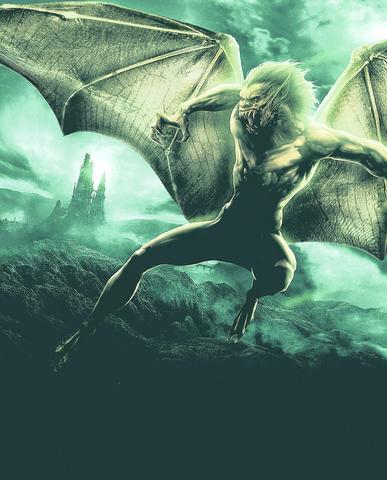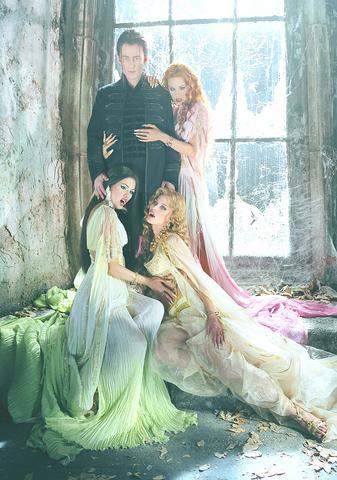Van Helsing reminds you of the NBA All-Star Game, where basketball superstars take turns scoring with flashy three-pointers or slam-dunks, no one plays defense and coaches rotate players in and out of the game so fans can see the entire rosters.
Van Helsing is, of course, an all-star monster mash featuring Universal's prized horror-film megastars of the 1930s and 1940s -- Dracula, Frankenstein's Monster, the Wolf Man and -- for good measure, though strictly speaking he was originally a Paramount monster -- Mr. Hyde.
Writer-director Stephen Sommers' idea to bring the studio's triumvirate of classic monsters together into one epic adventure film is, like an All-Star Game, a mixed blessing. The purposes of the original, high-atmospheric movies get distorted in the struggle to involve all the monsters in a credible tale. And the digital age encourages Sommers to leap from one elaborate sequence to the next without so much as a pause for a glass of blood. Nevertheless, this creature feature is exhilarating fun, a richly designed and often quite funny re-exploration of the movie past.

Sommers, who brought the Mummy back to life for Universal with his past two films, has delivered exactly what the studio wants in this reportedly US$148 million production: an event movie capable of attracting a wide audience that could send domestic box office gross north of US$150 million and make viable plans already under way for a sequel, TV show and video game.
Ruggedly handsome Hugh Jackman plays the title character with a steady gait and confident demeanor. Originally an aging Amsterdam professor specializing in exotic diseases in Bram Stoker's 1897 novel Dracula, Sommers has turned Van Helsing into a 19th-century monster hunter. He wears a cool broad-brimmed black hat and a sturdy body-length leather coat and carries an implausible rotary-magazine crossbow. (As in The Wild Wild West, Van Helsing's weaponry is both retro and futuristic.) He takes his orders from a secret organization composed of all religions to rid the world of nightmarish creatures but is uncertain and even conflicted over why he does so. For he has no memory of any past life.
In the film's opening in Transylvania, cinematographer Allen Daviau and designer Allan Cameron pay tribute to James Whales' dazzlingly beautiful 1935 Bride of Frankenstein when a frenzied, torch-lit mob armed with pitchforks and scythes surges toward Dr. Frankenstein's castle against a huge night sky. This sets the tone for the movie's look -- a respectful homage to the Universal classics that contemporary technology trumps with demonic creatures, sets of misshapen weirdness and a fantastical Eastern Europe of such cold darkness that the movie clearly takes place in a world ruled by evil forces.

PHOTOS COURTESY OF UNIVERSAL
Val Helsing is sent to Transylvania to confront 400-year-old Count Dracula (a mesmerizing Richard Roxburgh). He aligns himself, after initial and mutual resistance, with Anna Valerious (a luminous Kate Beckinsale), the last of a royal family line nearly eliminated by the vampire. Her brother Velkan (Will Kemp) has already been bitten by a werewolf, so he is fated at the next full moon to turn into the Wolf Man, who will act under Dracula's orders to destroy his own sister.
Dracula and his three vampire brides (Elena Anaya, Silvia Colloca and Josie Maran) desperately need Frankenstein's patched-together Monster (Shuler Hensley) to bring to life thousands of vampire children the three have sired. All, of course, were born dead.
Thus, the all-star matchup begins. There are two attacks on the village by the vampire brides, who can fly and swarm like bats. Van Helsing and Anna rescue Frankenstein's Monster, leading to a chase involving two six-horse coaches with Van Helsing thrown and landing in between two horses. The two monster hunters fight ambivalent battles with the Wolf Man, who after all is still partly Anna's brother. They crash an amazing All Hallow's Eve vampire costume ball with jugglers, flame throwers and circus performers.

Side battles between Anna and the three vampire brides lead to a climactic duel between Van Helsing, now bitten himself by a werewolf, and the Count. Comic relief comes from Carl (David Wenham), a nervous friar who supplies Van Helsing with his gadgets and weaponry, and sneering Igor (Kevin O'Connor), a misshapen doer of evil because, in his own deadpan words, "It's what I do."
Visually, Van Helsing is a stunner. The morphing monsters -- vampires who assume bat bodies with huge, muscular wings and humans who turn into creatures of the night -- magnificently blend digital with human forms. (Viewers even get a peek at the butt crack of CG creature Mr. Hyde.) There is more wire work in this movie than any circus as nearly every creature either flies or swings on ropes. The sets add drama but also humor. Consider the half-finished Eiffel Tower in the Paris sequence or Dracula's lair all electronically wired like a huge cappuccino machine to transform his pod "children" into legions of vampires.
Alan Silvestri's music merges choral with symphonic bombast and even a hint of 1970s disco. Only the damn soundtrack booms ceaselessly. Which brings up the movie's major drawback: Sommers fears a moment of quiet or a scene dominated by dialogue. Introspection is somehow equated with storytelling weakness, and subtlety is banished. Sommers wants his monster mash to rock nonstop at high-decibel levels. So bring your earplugs.

The canonical shot of an East Asian city is a night skyline studded with towering apartment and office buildings, bright with neon and plastic signage, a landscape of energy and modernity. Another classic image is the same city seen from above, in which identical apartment towers march across the city, spilling out over nearby geography, like stylized soldiers colonizing new territory in a board game. Densely populated dynamic conurbations of money, technological innovation and convenience, it is hard to see the cities of East Asia as what they truly are: necropolises. Why is this? The East Asian development model, with

June 16 to June 22 The following flyer appeared on the streets of Hsinchu on June 12, 1895: “Taipei has already fallen to the Japanese barbarians, who have brought great misery to our land and people. We heard that the Japanese occupiers will tax our gardens, our houses, our bodies, and even our chickens, dogs, cows and pigs. They wear their hair wild, carve their teeth, tattoo their foreheads, wear strange clothes and speak a strange language. How can we be ruled by such people?” Posted by civilian militia leader Wu Tang-hsing (吳湯興), it was a call to arms to retake

This is a deeply unsettling period in Taiwan. Uncertainties are everywhere while everyone waits for a small army of other shoes to drop on nearly every front. During challenging times, interesting political changes can happen, yet all three major political parties are beset with scandals, strife and self-inflicted wounds. As the ruling party, the Democratic Progressive Party (DPP) is held accountable for not only the challenges to the party, but also the nation. Taiwan is geopolitically and economically under threat. Domestically, the administration is under siege by the opposition-controlled legislature and growing discontent with what opponents characterize as arrogant, autocratic

When Lisa, 20, laces into her ultra-high heels for her shift at a strip club in Ukraine’s Kharkiv, she knows that aside from dancing, she will have to comfort traumatized soldiers. Since Russia’s 2022 invasion, exhausted troops are the main clientele of the Flash Dancers club in the center of the northeastern city, just 20 kilometers from Russian forces. For some customers, it provides an “escape” from the war, said Valerya Zavatska — a 25-year-old law graduate who runs the club with her mother, an ex-dancer. But many are not there just for the show. They “want to talk about what hurts,” she